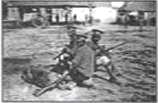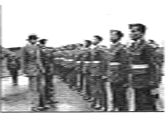
Introduction
Black History Month 2007
HISTORICAL CONTEXT
 The migration of people from the Caribbean to Britain in the 1940s, 1950s and 1960s was not something new, but part of a history of migration which had begun hundreds of years earlier. In fact African people had been present in Britain from as early as in Roman times, as part of the Roman army (which was made up of citizens from all over its empire), the most notable being the Emperor Septimus Severus (150 A.D. - 211 A.D.), who completely rebuilt Hadrian's Wall. passed in the U.S.A. considerably restricted the arrival number of Caribbean people who could settle there, which had hitherto been a much preferred destination. With this door closed to them, many Caribbean people looked to Britain, which gave all Commonwealth citizens the status of British citizenship, until restrictions on entry were imposed by the Commonwealth Immigrants Act of 1962.
The migration of people from the Caribbean to Britain in the 1940s, 1950s and 1960s was not something new, but part of a history of migration which had begun hundreds of years earlier. In fact African people had been present in Britain from as early as in Roman times, as part of the Roman army (which was made up of citizens from all over its empire), the most notable being the Emperor Septimus Severus (150 A.D. - 211 A.D.), who completely rebuilt Hadrian's Wall. passed in the U.S.A. considerably restricted the arrival number of Caribbean people who could settle there, which had hitherto been a much preferred destination. With this door closed to them, many Caribbean people looked to Britain, which gave all Commonwealth citizens the status of British citizenship, until restrictions on entry were imposed by the Commonwealth Immigrants Act of 1962.
Following the European colonisation of the Americas and the subsequent enslavement of Africans, there were so many black people in England during the reign of Queen Elizabeth I that she issued a Royal proclamation in 1601 that they should be repatriated. Advertisements in newspapers throughout the late seventeenth and eighteenth centuries are evidence of the fact that black people were being bought and sold as property, and that it was quite fashionable to keep black servants. Moreover, there were many free black people, including black American slaves who had earned their freedom by fighting for the British during the American War of Independence. Ex-slaves, who wrote and spoke of their lives as slaves, such as Olaudah Equiano, were key figures in the movement for the abolition of the slave trade in Britain. However, after slavery was abolished throughout the British Empire in 1834, many former slaves migrated to Britain from the various Caribbean Islands and this pattern continued until the 1930s when the depression brought a pause to this movement.
 The Second World War, as did the First World War, saw people of the Empire joining with the "Mother Country" to fight and work for victory. Men and women arrived from the Caribbean in their thousands to work as civilians or in the armed forces. After the war, many stayed on in Britain, others went back to the Caribbean for a while but some soon British West Indian Regiment, Albert-Amiens Rd. Sept. 1916 returned. In the years immediately following the war, a combination of "push" factors, such as high unemployment, low wages, over-population and a general lack of opportunities in the Caribbean, and "pull" factors, such as a great labour shortage in Britain and active recruitment, led to the beginning of large scale migration of Caribbean people to Britain. However the reasons were not this simple, other factors were at play. For example increased prosperity in many Caribbean Islands in the 1950s and 1960s (mainly from tourism and bauxite mining) meant that more money was available for the passage overseas. Moreover, the 1952 McCarran-
The Second World War, as did the First World War, saw people of the Empire joining with the "Mother Country" to fight and work for victory. Men and women arrived from the Caribbean in their thousands to work as civilians or in the armed forces. After the war, many stayed on in Britain, others went back to the Caribbean for a while but some soon British West Indian Regiment, Albert-Amiens Rd. Sept. 1916 returned. In the years immediately following the war, a combination of "push" factors, such as high unemployment, low wages, over-population and a general lack of opportunities in the Caribbean, and "pull" factors, such as a great labour shortage in Britain and active recruitment, led to the beginning of large scale migration of Caribbean people to Britain. However the reasons were not this simple, other factors were at play. For example increased prosperity in many Caribbean Islands in the 1950s and 1960s (mainly from tourism and bauxite mining) meant that more money was available for the passage overseas. Moreover, the 1952 McCarran- Walter Act passed in the U.S.A. considerably restricted the arrival number of Caribbean people who could settle there, which had hitherto been a much preferred destination. With this door closed to them, many Caribbean people looked to Britain, which gave all Commonwealth citizens the status of British citizenship, until restrictions on entry were imposed by the Commonwealth Immigrants Act of 1962.
Walter Act passed in the U.S.A. considerably restricted the arrival number of Caribbean people who could settle there, which had hitherto been a much preferred destination. With this door closed to them, many Caribbean people looked to Britain, which gave all Commonwealth citizens the status of British citizenship, until restrictions on entry were imposed by the Commonwealth Immigrants Act of 1962.
On the whole immigration was not intended to be permanent. The hopes and aims were mainly focused on the return home, and the ambition of achieving the means of buying a home was high on a list of aspirations including also the acquisition of a skill or other educational qualifications. Generally speaking, young people wanted to "better themselves" by going overseas for a few years, young children often being left with grandparents. They tended to live in areas where industries that needed manpower happened to be. In Gloucester, the Foundry was a major employer of Caribbean people and, as in other parts of the country, the "service" industries attracted many workers, with many women working in shops and hospitals.
However, all was not as they expected. Many of the glowing reports sent back by those who came first were not experienced by those who came later. Despite warnings they were not prepared for the cold. The distance between their home and Britain (and also between towns and cities in Britain), certainly wasn't appreciated by people who only had experience of small islands, especially when fares were dramatically lowered by the new shipping services introduced by Italian and Spanish lines. Friends and relatives were not always that easy to find. They couldn't get the food they were used to. Wages, which in cash terms sounded vastly more than wages at home, were not measured against the additional costs of housing, clothing, heating and food. The racial situation was one of the major areas of disillusionment. They certainly  didn't expect the antagonism and rejection that many faced. Their difficulties infinding accommodation led to overcrowding as they helped each other out. However, they didn't see this as a problem, but as mutual support. In pooling finances, through "pardners", many were able to put a deposit down on their own home when their "hand" became due. Moreover, many sent the passage money for other family members to join them, maintained dependants back home and invested in property there. The rapid success many had anticipated was not easy to achieve. As partners joined them, as families came along, as bills mounted, it became clear that their stay was to become lengthy.
didn't expect the antagonism and rejection that many faced. Their difficulties infinding accommodation led to overcrowding as they helped each other out. However, they didn't see this as a problem, but as mutual support. In pooling finances, through "pardners", many were able to put a deposit down on their own home when their "hand" became due. Moreover, many sent the passage money for other family members to join them, maintained dependants back home and invested in property there. The rapid success many had anticipated was not easy to achieve. As partners joined them, as families came along, as bills mounted, it became clear that their stay was to become lengthy.
Gail johnson





